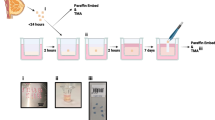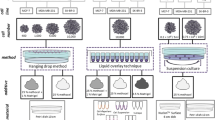Abstract
Regular expansion of heterogeneous populations of epithelial cells, including the luminal phenotype, was achieved from small biopsies of human breast tumours and cutaneous metastases by optimized feeder layer technique based on irradiated NIH 3T3 cells. Forty-one out of 47 primary tumour specimens and all three cutaneous metastases grew successfully for two to 10 passages in vitro. The main phenotypes of cultured cells and their changes in subcultures were characterized using immunocytochemistry and phase contrast microscopy (in few cases also time-lapse recording). In the majority of cultured cell populations a fraction of cells positive for keratin 19 (K19+), typical for the luminal phenotype, was detected. This is the cell type from which breast carcinoma is supposed to arise. While in cultures derived from benign lesions only basic phenotypes of luminal and myoepithelial cells were found, in cultures derived from malignant tumours unusual phenotypes of epithelial cells, in their majority K19+, were detected. The growth properties of cells from six benign and seven malignant samples were analyzed in detail. In the analyzed cell populations the culture lifetime – related to the number of colony-forming cells – varied for cells from malignant tumours between 21 and 51 and from benign tumours between 22 and 40 cell generations. The total number of passages achieved was three to seven for malignant or four to nine for benign cultures. In spite of negative results of tumourigenicity testing in immunologically compromised Nu/nu mice the potential to culture apparently neoplastic cells was indicated by positive immunostaining for the p53 oncoprotein (seven of 23 tested malignant cases), the src oncoprotein (five of eight), and overexpression of the c-erbB-2 protein (five of 26). This was further confirmed by successful cultivation of malignant cells from cutaneous metastases. Two of the three metastasis-derived cultures were nearly homogeneously positive for K19 while the third was almost negative. The results proved the optimized feeder layer technique to be useful for regular yielding of large amounts of epithelial cells from small tumour biopsies and for supporting the majority of cell phenotypes present in the original tumour. Therefore, it appeared to be a promising tool for further analysis of interactions between luminal and myoepithelial cells in the development of human breast carcinoma and for the study of individual tumours.
Similar content being viewed by others
References
O'Hare MJ: Breast cancer. In: Masters JRW (ed) Human Cancer in Primary Culture, A Handbook. Kluwer Academic Publishers, Dordrecht, The Netherlands, 1991, pp 271–286
Taylor-Papadimitriou J, Berdichevsky F, D'souza, Burchell J: Human models of breast cancer. Cancer Surv 16: 59–78, 1993
Dairkee SH, Deng G, Stampfer MR, Waldman FM, Smith HS: Selective cell culture of primary breast carcinoma. Cancer Res 55: 2516–2519, 1995
Band V, Zajchowski D, Swisshelm K, Trask D, Kulesa V, Cohen C, Connolly J, Sager R: Tumour progression in four mammary epithelial cell lines derived from the same patient. Cancer Res 50: 7351–7357, 1990
Barcellos-Hoff MH, Aggeler J, Ram TG, Bissell MJ: Functional differentiation and alveolar morphogenesis of primary mammary cultures on reconstituted basement membrane. Development (Cambridge) 105: 223–235, 1989
Bergstraesser LM, Weitzman SA: Culture of normal and malignant primary human mammary epithelial cells in a physiological manner simulates in vivo growth patterns and allows discrimination of cell type. Cancer Res 53: 2644–2654, 1993
Taylor-Papadimitriou J, Stampfer M, Bartek J, Lewis A, Boshell M, Lane EB, Leigh IM: Keratin expression in human mammary epithelial cells cultured from normal and malignant tissue: relation to in vivo phenotypes and influence of medium. J Cell Sci 94: 403–413, 1989
Stampfer MR, Hallowes RC, Hackett AJ: Growth of normal human mammary cells in culture. In vitro 16: 415–425, 1980
Hammond SL, Ham RG, Stampfer MR: Serum-free growth of human mammary epithelial cells: rapid clonal growth in defined medium and extended serial passage with pituitary extract. Proc Natl Acad Sci USA 81: 5435–5439, 1984
Band V, Sager R: Distinctive traits of normal and tumourderived human mammary epithelial cells expressed in a medium that supports long-term growth of both cell types. Proc Natl Acad Sci USA 86: 1249–1253, 1989
Ethier SP, Mahacek ML, Gullick WJ, Frank TS, Weber BL: Differential isolation of normal luminal mammary epithelial cells and breast cancer cells from primary and metastatic sites using selective media. Cancer Res 53: 627–635, 1993
Bártek J, Taylor-Papadimitriou J, Miller N, Millis R: Patterns of expression of keratin 19 as detected with monoclonal antibodies in human breast tissues and tumours. Int J Cancer 36: 299–306, 1985
Stampfer MR Cholera toxin stimulation of human mammary epithelial cells in culture. In vitro 18: 531–537, 1982
Smith HS, Lan S, Ceriani R, Hacket AJ, Stampfer MR: Clonal proliferation of cultured nonmalignant and malignat human breast epithelia. Cancer Res 41: 4637–4643
O'Hare MJ, Ormerod MG, Monaghan P, Lane EB, Gusterson BA: Characterization in vitro of luminal and myoepithelial cells isolated from the human mammary gland by cell sorting. Differentiation 46: 209–221, 1991
Petersen OW, van Deurs B: Preservation of defined phenotypic traits in short-term cultured human breast carcinoma derived epithelial cells. Cancer Res 47: 856–866, 1987
Matoušsková E, Dudorkinová D, Krásná L, Veselý P: Temporal in vitro expansion of the luminal lineage of human mammary epithelial cells achieved with the 3T3 feeder layer technique. Breast Cancer Res Treat 60: 241–249, 2000
Rheinwald JG, Green H: Serial cultivation of strains of human epidermal keratinocytes: the formation of keratinizing colonies from the single cells. Cell 6: 331–344, 1975
Rheinwald JG, Green H: Epidermal growth factor and the multiplication of cultured human epidermal keratinocytes. Nature 265: 421–424, 1977
Matoušsková E, Dudorkinová D, Pavlíková L, Povýšsil C, Veselý P: Clonal expansion of epithelial cells from primary human breast carcinoma with 3t3 feeder layer technique. Folia Biol (Praha) 44: 67–71, 1998
Purkis PE, Steel JB, Mackenzie IC, Nathrath WB, Leigh IM, Lane EB: Antibody markers of basal cells in complex epithelia. J Cell Sci 97: 39–50, 1990
Zicha D, Dunn GA: An image processing system for cell behaviour studies in subconfluent cultures. J Microsc 179: 11–21, 1995
Matoušsková E, McKay I, Povýšsil C, Königová R, Chaloupková A, Veselý P: Characterization of the differentiated phenotype of an organotypic model of skin derived from human keratinocytes and dried porcine dermis. Folia Biol (Praha) 44: 59–66, 1998
Dairkee SH, Paulo EC, Traquina P, Moore DH, Ljung BM, Smith H: Partial enzymatic degradation of stroma allows enrichment and expansion of primary breast tumour cells. Cancer Res 57: 1590–1596, 1997
Taylor-Papadimitriou J, Shearer M, Stoker GP: Growth requirements of human mammary epithelial cells in culture. Int J Cancer 20: 903–908, 1977
Veselý P, Boyde A, Jones SJ: Behaviour of osteoclasts in vitro: contact behaviour of osteoclasts with osteoblast-like cells and networking of osteoclasts for 3D orientation. J Anat 181: 277–291, 1992
Fusening NE: Epithelial-mesenchymal interactions regulate keratinocyte growth and differentiation in vitro. In: Leigh IM, Lane EB, Watt FM (eds) The Keratinocyte Handbook. Cambridge University Press, Cambridge, 1994, pp 71–94
Bissell MJ, Weaver VM, Lelievre SA, Wang F, Petersen OW, Schmeichel KL: Tissue culture, nuclear organization, and gene expression in normal and malignant breast. Cancer Res 59 (7 Suppl): 1757–1763s, 1999
Wang ChS, Goulet F, Lavoie J, Drouin R, Auger F, Champetier S, Germain L, Tetu B: Establishment and characterization of a new cell line derived from a human primary breast carcinoma. Cancer Genet Cytogenet 120: 58–72, 2000
Price JE, Polyzos A, Zhang RD, Daniels LM: Tumourigenicity and metastasis of human breast carcinoma cell lines in nude mice. Cancer Res 50: 717–721, 1990
Amadori D, Bertoni L, Flamigni A, Savini S, De Giovanni C, Casanova S, De Paola F, Amadori A, Giulotto E, Zoli W: Establishment and characterization of a new cell line from primary human breast carcinoma. Breast Cancer Res Treat 28: 251–260, 1993
Petersen OW, van Deurs B, Nielsen KV, Madsen MW, Laursen I, Balslev I, Briand P: Differential tumourigenicity of two autologous human breast carcinoma cell lines, HMT-3909S1 and HMT-3909S8, established in serum-free medium. Cancer Res 50: 1257–1270, 1990
Shearer M, Bártková J, Bártek J, Berdichevsky F, Barnes D, Millis R, Taylor-Papadimitriou J: Studies of clonal cell lines developed from primary breast cancers indicate that the ability to undergo morphogenesis in vitro is lost early in malignancy. Int J Cancer 51: 602–612, 1992
Brunner A, Boysen B, Romer J, Spang-Thomsen M: The nude mouse as an in vivo model for human breast cancer invasion and metastasis. Breast Cancer Res Treat 24: 257–264, 1993
Clarke R: Human breast cancer cell line xenografts as models of breast cancer. The immunobiologies of recipient mice and the characteristics of several tumourigenic cell lines. Breast Cancer Res Treat 39: 69–86, 1996
Thompson FH: Cytogenetic methodological approaches and findings in human solid tumours. In: Barch MJ (ed) The ACT Cytogenetic Laboratory Manual. 2nd edn, The Association of Cytogenetic Technologists, Raven Press, New York, 1991, pp. 451–484
Zaretsky JZ, Weiss M, Tsarfaty I, Hareuveni M, Wreschner DH, Keydar I: Expression of genes coding for pS2, c-erbB2, estrogen receptor and the H23 breast tumour-associated antigen. A comparative analysis in breast cancer. FEBS Lett 265: 46–50, 1990
Verbeek BS, Vroom TM, Adriaansen-Slot SS, Ottenhoff-Kalff AE, Geertzema JGN, Hennipman A, Rijksen G: c-Src protein expression is increased in human breast cancer. An immunohistochemical and biochemical analysis. J Pathol 180: 383–388, 1996
Author information
Authors and Affiliations
Rights and permissions
About this article
Cite this article
Krásná, L., Dudorkinová, D., Vedralová, J. et al. Large expansion of morphologically heterogeneous mammary epithelial cells, including the luminal phenotype, from human breast tumours. Breast Cancer Res Treat 71, 219–235 (2002). https://doi.org/10.1023/A:1014457731494
Issue Date:
DOI: https://doi.org/10.1023/A:1014457731494




